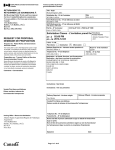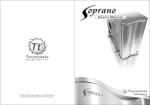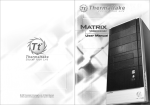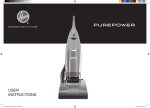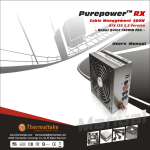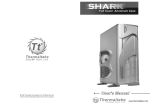Download PurePower 1050 User`s guide
Transcript
User’s Guide and Warranty Information PurePower 120 Volt models Contents Table of Contents About the PurePower APS 2 Safety Warnings 3 Installation Inspecting the Equipment 4 PurePower Preparation 5 Activating Up Your PurePower 8 Operation 12 PurePower Maintenance 13 Specifications 14 Troubleshooting 16 Service and Support 17 Audiophile Power Supply • www.audiophileaps.com | 01 About the Audiophile APS The PurePower Audio Power Supply The Audiophile Audio Power Supply (APS) provides pure regenerated power for your sensitive home theater and audio equipment. This is accomplished through our double conversion technology. We convert the incoming AC power to produce a clean DC supply, then recreate a new, 60 Hz, 120 volt AC wave form from the DC. We make sure that your system gets the power it was designed for and your amplifiers get the current they need for top performance. The APS also protects from power disturbances including power sags, power surges, overvoltages, line noise, undervoltages, frequency variations, switching transients and harmonic distortion. Power disturbances have the potential to damage sensitive hardware causing expensive repairs with either catastrophic failures or degradation over time through chronic overheating. With the APS you can safely eliminate the effects of power disturbances and guard the integrity of your equipment. In addition to pure power, the Audiophile APS provides you with something unique in audio power regenerators - protection against power outage. The Audiophile APS maintains full wattage output even when the power fails completely. Providing outstanding performance and reliability, the PurePower’s unique benefits include the following: • True double conversion AC regeneration design with pure sine wave output. The APS filters and regulates incoming AC power, creates a DC source, then regenerates new pure AC and provides monitored, consistent power to your components. • The APS improves amplifier performance by ensuring full wattage and improves signal com ponent output quality by removing noise and distortion. • The PurePower APS design allows any of our 6 available high quality, full contact receptacles to supply digital, analog or amplifier components. • Hours of extended viewing or listening time with optional APS PowerPack Modules during outages. • Optional Line surge protection guards against spikes and surges on coax or RJ11 lines. • Start on battery capabilities allows you to power up the APS even if utility power is not available. 02 | Pure Power in > Pure Sound out Safety Warnings Safety Warnings Read the following precautions before you install the APS. IMPORTANT SAFTEY INSTRUCTIONS - SAVE THESE INSTRUCTIONS. This manual contains important instructions that you should follow during installation and maintenance of the APS and batteries. Please read all instructions before operating the equipment and save this manual for future reference. DANGER This APS contains LETHAL VOLTAGES. All repairs and service should be preformed by AUTHORIZED SERVICE PERSONNEL ONLY. There are NO USER SERVICEABLE PARTS inside the APS. WARNING This APS contains its own energy source. The output receptacles may carry live voltage even when the APS is not plugged in. Under normal operating conditions, do not remove or unplug the input cord when the APS is turned on. This removes the safety ground from the APS and the equipment connected to the APS. To reduce the risk of fire or electric shock, install this APS in a temperature and humidity controlled, indoor environment, free of conductive contaminants. Ambient temperature must not exceed 32°C (90°F). Do not operate near water or excessive humidity (95% max). To comply with international standards and wiring regulations, the total equipment connected to the output of this APS must not have an earth leakage current greater than 1.5 milliamperes. CAUTION Batteries can present a risk of electrical shock or burn from high short-circuit current. Observe proper precautions. Servicing should be preformed by qualified service personnel knowledgeable of batteries and required precautions. Proper disposal of batteries is required. Refer to your local codes for disposal requirements. Never dispose of batteries in a fire. Batteries may explode when exposed to flame. Audiophile Power Supply • www.audiophileaps.com | 03 Installation Inspecting the Equipment Before installation, please check to ensure that your PurePower APS package is complete and undamaged. If any deficiencies are discovered, please contact your PurePower Dealer. Shipping damage If any equipment has been damaged during shipment, keep the shipping cartons and packing materials for the carrier or place of purchase and file a claim for shipping damage. If you discover damage after acceptance, file a claim for concealed damage. To file a claim for shipping damage or concealed damage: 1) File with the carrier within 15 days of receipt of the equipment 2) Send a copy of the damage claim within 15 days to your Audiophile APS dealer. 04 | Pure Power in > Pure Sound out Installation APS Preparation The APS is designed for flexible configurations and can be rack mounted or placed on a shelf or as a standalone cabinet. If you are installing the APS in a rack, follow the instruction in “Rack-Mount Setup”. Standalone / shelf component When you position the APS horizontally on a shelf or in a non-rack style AV equipment stand or enclosure, ensure there is sufficient clearance for airflow through the grilles at front and rear of the unit. Figure 1. Horizontal Cabinet Setup Audiophile Power Supply • www.audiophileaps.com | 05 Installation 06 | Pure Power in > Pure Sound out Installation Rack-Mount The APS can be installed in 19 or 23-inch racks and needs only 2U of rack space. Mounting rails or a rack shelf are required for your Audiophile APS. If rails are not already installed in your rack or included with your APS, contact your PurePower dealer. Use the following procedure to install the APS in a rack: · Place the APS on a flat, stable surface with the front of the APS facing toward you. · Attach the mounting handles to the bracket with the screws provided in the accessory kit. · Remove the screws attaching the front bezel from one side of the unit. Align the rack mounting brackets with the screw holes on the side of the APS and replace screws. · Repeat for the opposite side. If installing optional PowerPacks, repeat Steps 1 through 4 for each cabinet. NOTE The PowerPacks must be installed BELOW the APS. Slide the APS and any optional PowerPacks into the rack. Continue to “Installing the APS” to complete the installation. Audiophile Power Supply • www.audiophileaps.com | 07 Installation Activating your PurePower APS The following steps explain how to install and start the APS. Activating the APS · Plug the components to be supplied into the APS output receptacles. The PurePower APS design allows any outlet to supply digital, analog or power amplifier components. · DO NOT operate electric space heaters with the APS. · Plug the APS power cord into a utility outlet. All front panel indicators flash briefly and the APS conducts a self-test. When the self-test is complete, the ~ indicator flashes, indicating the APS is in standby mode. If any other indicator flashes, see troubleshooting page. · Start the APS by pressing the On | button. The ~ indicator stops flashing and the bar graph indicators display the percentage of available power being supplied by the APS. The PurePower APS is now in Normal mode and supplying power to your system. 08 | Pure Power in > Pure Sound out Installation Installing optional Power Packs Modules must be installed before powering the APS. CAUTION: A small amount of arcing may occur when connecting a PowerPack Module to the APS. This is normal and will not harm you. Insert the connection cable into the APS battery connector quickly and firmly. · Plug the first PowerPack cable into the battery connector on the APS rear panel · If additional PowerPacks are to be installed, plug the cable of the second cabinet into the battery connector on the previous Powerpack NOTE: The batteries charge to 80% capacity in approximately 2 hours. However, it is recommended that the batteries charge for 24 hours after installation or long-term storage. The battery charging process will occur during normal operation and will not interfere with the supply of power from the APS. Audiophile Power Supply • www.audiophileaps.com | 09 Operation Operation The PurePower Front panel indicates the APS status through the LED indicators. Figure below shows the APS front panel indicators and controls. Figure 15. APS Front Panel Normal Mode During Normal mode, the ~ indicator illuminates and the front panel displays the percentage of APS load capacity being used by your system. (see Figure). The APS monitors and provides power to your system and charges the batteries as needed. The LEDs do not illuminate when the APS load is less than approximately 10%. Each LED represents a percentage of a full load rating. If all of the bar graph indicators are illuminated and the red overload indicator flashes, power requirements exceed APS capacity. less than 10% 10 - 25 % 25 - 50 % 50 - 75 % 75 - 100 % overloaded 10 | Pure Power in > Pure Sound out Operation Battery Mode When the APS is operating during a power outage, the battery indicator illuminates. The front panel displays the approximate percentage of battery capacity remaining (see figure 17). When the utility power returns, the APS switches back to Normal mode operation and the batteries recharge. If battery capacity becomes low while in battery mode, the battery indicator flashes indicating approximately three minutes of battery time remaining. When shutdown is imminent, the self test (checkmark) indicator flashes. These warnings are approximate, and the actual time to shutdown may vary. When utility power is restored after an APS shut down, the APS automatically restarts. 100 % 75 % 50 % 25 % 3 Mins. remaining shutdown imminent Bypass Mode In the event of an extended APS overload or internal failure, the APS transfers your system to utility power. Battery mode is not available, however the utility power continues to be passively filtered by the APS. The bypass indicator illuminates when bypass mode is engaged. The APS switches to Bypass mode when: · The APS has an overtemperature condition. · The APS has an overloaded condition of 101 to 110% for 2 minutes. · The APS has an overloaded condition of 111 to 150% for 30 seconds. · The APS detects a fault in the battery or APS electronics. Standby Mode When the APS is plugged in initially, or is turned off and remains plugged into a power outlet, the APS is in Standby mode. The ~ indicator flashes and the bar graph indicators are not lit, indicating that the APS output receptacles are off. Audiophile Power Supply • www.audiophileaps.com | 11 Operation Turning the PurePower On After the APS is connected to a power outlet, it conducts a self-test and enters Standby mode. To turn on the APSoutput power, press the On | button on the front panel. The ~ indicator illuminates and the bar graph indicators display the percentage of available power being supplied by the APS. Starting the PurePower APS on battery To turn on the APS without using utility power, press and hold the On | button for a least four seconds. The APS supplies power to your equipment and goes into Battery mode. When the APS starts on battery, it does not conduct a self-test to conserve battery power. Turning the PurePower APS off To turn off the APS: · Press and hold the off button for approximately three seconds. · The APS switches to Standby mode and removes power from the APS output receptacles. · Unplug the APS from the power outlet; the APS shuts down in five seconds. All front panel indicators flash briefly prior to shutdown. · If you do not unplug the APS, it remains in Standby mode. NOTE: Pressing the off button while the APS is in Battery mode causes the APS to shut down immediately. Initiating the Self-Test Press and hold the alert button for three seconds to initiate the self-test. During the five-second test, the bar graph indicators cycle through twice. If the APS finds a problem, a LED indicates where the problem is. For more information, see the “Troubleshooting” section. NOTE: The batteries must be fully charged and the APS must be in normal or standby mode to perform the self-test. 12 | Pure Power in > Pure Sound out APS Maintenance PurePower Maintenance PurePower APS and Battery Care For the best preventive maintenance, keep the area around the APS clean and dust-free. If the atmosphere is very dusty, clean the outside of the system with a vacuum cleaner. For full battery life, keep the APS at an ambient temperature of 21° C (72° F). Storing the APS and Batteries If you store the APS for a long period, recharge the batteries every 12 months by plugging the APS into a power outlet. The batteries charge to 80% capacity in approximately 2 hours. However, it is recommended that the batteries charge for 24 hours after long-term storage. When to Replace Batteries When the battery indicator illuminates, the batteries may need replacing. Conduct a self-test. If the battery indicator stays on, contact Audiophile or your Audiophile dealer to order new batteries. The average battery life is aproximately 5-7 years. The PurePower APS will still provide full power conditioning and protection when the batteries need replacement, but it will not be able to continue to operate during a power outage. You may perform the battery replacement yourself by ordering an Audiophile battery replacement kit. Full instructions are included with the kit and are also available on our web site. Audiophile Power Supply • www.audiophileaps.com | 13 Specifications Specifications This section provides the following specifications for the PurePower APS · Electrical input and output · Weights and dimensions · Environmental and safety · Battery Model List PurePower APS Model 500 PurePower APS Model 700 PurePower APS Model 1050 Watts 490 700 1050 Weight Lb. (kg) 34 (15) 34 (15) 50 (23) Dimensions (HxWxD) 3.5 x 17 x 19.5” 3.5 x 17 x 19.5” 3.5 x 17 x 19.5” Electrical Input Nominal Voltage Voltage Range Frequency Range Noise filtering Input Connections 120V 80 – 144V 45-65Hz, 50/60 Hz auto-sensing MOVs & line filter for normal & common mode noise IEC-320 Input receptacle with supplied 6’ power cord Electrical Outputs Output Voltage Voltage Regulation Voltage Waveform Output Receptacles Energy Efficiency 14 | 120 VAC Nominal output voltage ±2% Normal mode: Sine wave; <3% THD with full PFC (6) 5-15 R 89 - 92 % depending on load Pure Power in > Pure Sound out Specifications Environmental and Safety Operating Temperature Optimal battery performance: Storage Temperature Transit Temperature Relative Humidity Operating Altitude Transit Altitude Audible Noise Surge Suppression Safety Conformance Safety Markings EMC (Class B) 0°C to 32°C (32°F to 90°F) 21°C (72°F) 0°C to 25°C (32°F to 77°F) -25°C to 55°C (-13°F to 131°F) 5-90% noncondensing Up to 3,000 meters above sea level Up to 10,000 meters above sea level Less than 20 dBA ANSI C62.41 Category B (formerly IEEE 587) UL 1778, UL 497A; CAN/CSA C222.2, No. 107.1, 107.2 NOM-019-SCFI UL CSA Entella FCC Part 15, ICES-003, VCCI Class B EMC Statement FCC Part 15 Note: This equipment has been tested and found to comply with the limits for a class B digital device, pursuant to part 15 to the FCC Rules. These limits are designed to provide reasonable protection against harmful interference in a residential installation. This equipment generates, uses and can radiate radio frequency energy and, if not installed and used in accordance with the instructions, may cause harmful interference to radio communications. However, there is no guarantee that interference will not occur in a particular installation. If this equipment does cause harmful interference to radio or television reception, which can be determined by turning the equipment off and on, the user is encouraged to try to correct the interference by one or more of the following measures: • Reorient or relocate the receiving antenna. • Increase the separation between the equipment and the receiver. • Connect the equipment into an outlet on a circuit different from that it which the receiver is connected. • Consult the dealer or and experienced radio/television technician for help. ICES-003 This Class B Interference Causing Equipment meets all requirements of the Canadian Interference Causing Equipment Regulations ICES-003 Audiophile Power Supply • www.audiophileaps.com | 15 Troubleshooting Troubleshooting your PurePower APS This section contains troubleshooting information and an explanation of APS alarm conditions. Condition Possible Cause Resolution The normal mode indicator is not on or APS won’t start Power cord not connected Wall outlet is faulty Check connections Have outlet checked and repaired Normal mode indicator flashing, no power output APS is in standby mode Press the on button to switch to normal mode Battery indicator is lit Utility power failure APS is not connected to wall none Check Input power cable Bypass indicator is lit APS in bypass mode Your components have been transferred to utility power. Power filtering an surge suppression are active. Check other fault indicators for cause. Bypass indicator flashing Bypass mode not available Input power not within acceptable standards, APS will continue to supply your components. Battery indicator flashing Battery fully discharged Allow batteries to charge for 24 hours then hold alarm reset button for 3 secs. for self test. Replace the batteries or contact your dealer. Battery failure Ground fault indicator flashing No ground wire or line or neutral reversed in wall Have the outlet wiring corrected Overtemp indicator flashing Internal temp too high Turn off and unplug APS, allow to cool. check for blocked vents and that airflow is not restricted. If problem persists, contact your dealer. Overload indicator flashing, APS turns off output Power demand exceeds APS overload capacity* Turn off and unplug APS. Wait 5 seconds, restart APS. If problem persists, remove components from APS until wattage is within APS rating. Some amplifiers have extremely high power draws excessive voltage* on startup. A higher wattage APS model may be required. Amplifier startup demands * The Audiophile APS is capable of supporting up to 110% of its rated capacity for 2 minutes and up to 150% of its rated capacity for 30 seconds. 16 | Pure Power in > Pure Sound out Service & Support Service And Support For setup and support for your PurePower APS, please contact your authorized PurePower Dealer. For warranty service, please contact your authorized dealer or Audiophile APS. All PurePower APS models have a two year swap out warranty for original registered owners. If we are unable to solve a problem with your APS over the phone, we’ll send you a replacement unit. Just return the original in the same packaging with the supplied shipping documentation. For technical support and warranty service, Please contact Audiophile APS via: email: [email protected] | phone at 519.624.9735 | fax at 519.624.9592 Audiophile Power Supply • www.audiophileaps.com | 17 Pure Power in > Pure Sound out • www.audiophileaps.com



















